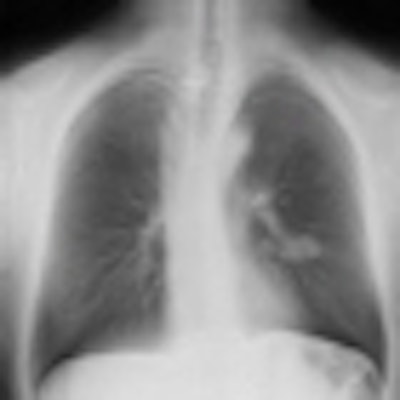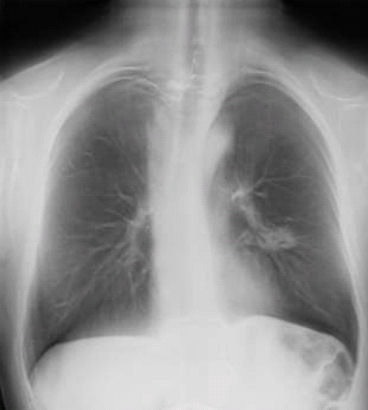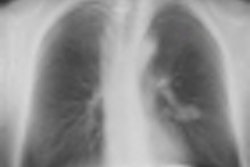
Italian researchers presenting at this week's European Lung Cancer Conference (ELCC) in Geneva believe that digital chest tomosynthesis could eventually become a "mammogram for the lungs" by enabling lung cancer screening of high-risk individuals -- at a lower cost than CT.
Researchers from S. Croce e Carle Hospital in Cuneo, Italy, presented a paper that details their experiences in screening more than 1,800 current and former smokers with a digital tomosynthesis unit, a specially adapted digital radiography (DR) system with a tube head that pans around the patient, collecting multiple image acquisitions. The system achieved a lung cancer detection rate on par with recent clinical studies based on low-dose CT screening.
The Italian research team presented preliminary data on the study at the 2011 RSNA meeting. The study being presented this week at ELCC includes data from a larger number of patients.
 Digital chest tomosynthesis uses an upgraded DR system with a panning tube head. Image courtesy of Dr. Luca Bertolaccini.
Digital chest tomosynthesis uses an upgraded DR system with a panning tube head. Image courtesy of Dr. Luca Bertolaccini.Results presented at both meetings have led the researchers to postulate that digital chest tomosynthesis could eventually be used as a sort of triage tool for chest screening of high-risk individuals, with suspicious or more complex cases referred for further examination with low-dose CT.
Inspired by NLST study
The researchers said they acquired their first digital tomosynthesis unit (Definium 8000 with VolumeRAD, GE Healthcare) in December 2009, intrigued by papers in the literature that indicated the technology could offer digital imaging of the chest with accuracy similar to CT, according to Dr. Luca Bertolaccini, who along with Dr. Alberto Terzi is lead co-author on the study.
They became interested in digital tomosynthesis's potential as a screening tool following publication of results from the National Lung Screening Trial (NLST) in 2010, which found that CT screening of high-risk individuals could reduce mortality by 20%.
"These results showed that lung cancer screening can reduce mortality. But to prevent one death, 320 high-risk individuals have to be screened with low-dose CT," Bertolaccini told AuntMinnieEurope.com. "The conclusion is that other strategies for detection of lung cancer must be researched."
To that end, the researchers enrolled 1,843 subjects in a lung screening program, with inclusion criteria calling for the screening of individuals between the ages of 45-70 years who were current or former smokers for at least 20 pack-years, and who had no previous history of malignancy in the last five years. Average age of the population was 61.
With the tomosynthesis protocol, up to 80 projection images were acquired in about 11 seconds as the x-ray system's tube head pans around the patient. System settings were 120 kV, automatic exposure control (AEC) of 400, and a 1:10 dose ratio. Radiation dose was estimated with a RANDO phantom and Monte Carlo dose simulation techniques.
All study subjects had one baseline round of digital tomosynthesis screening, with one yearly repeat screening study. Individuals with suspicious nodules detected on tomosynthesis were sent to CT for additional follow-up.
Researchers analyzed results from 1,500 individuals who were screened, finding 268 pulmonary and 13 nonpulmonary abnormalities. First-line CT was conducted in 132 individuals, follow-up CT in 68 cases, and PET/CT in 27 subjects.
They found 18 lung nodules positive for lung cancer, for a detection rate of 1.2%. There were 39 false positives on the first-line CT scans, for a false-positive rate of 3.9%.
The detection numbers are in line with other CT lung screening studies, according to Bertolaccini, where detection rates have ranged from 0.4%-2.7% for the Early Lung Cancer Action Project (ELCAP) study to 0.9% for the Dutch NELSON study.
The researchers found an edge for tomosynthesis in both radiation dose and cost. The mean effective dose delivered by the tomosynthesis scans was 0.24 mSv, compared to 1.5-3.8 mSv for low-dose CT. The tomosynthesis exams cost 44 euros ($58 U.S.), compared to 227 euros ($298 U.S.) for a screening CT study.
Next steps for tomo
Proponents of digital tomosynthesis have offered hope that the technology could prove to be an alternative to CT for tasks such as working up suspicious lesions, at both a lower cost and lower radiation dose. But the current study is one of the first to explore a screening role for tomosynthesis, especially given radiography's inconsistent history as a lung screening tool.
Bertolaccini's group plans to conduct follow-up studies, but if everything goes to plan, they have high hopes for digital tomosynthesis.
"We think that digital tomosynthesis could be the mammogram of the lung," Bertolaccini said. "If our data could be confirmed from other centers with a similar protocol, the results could be very interesting."



















